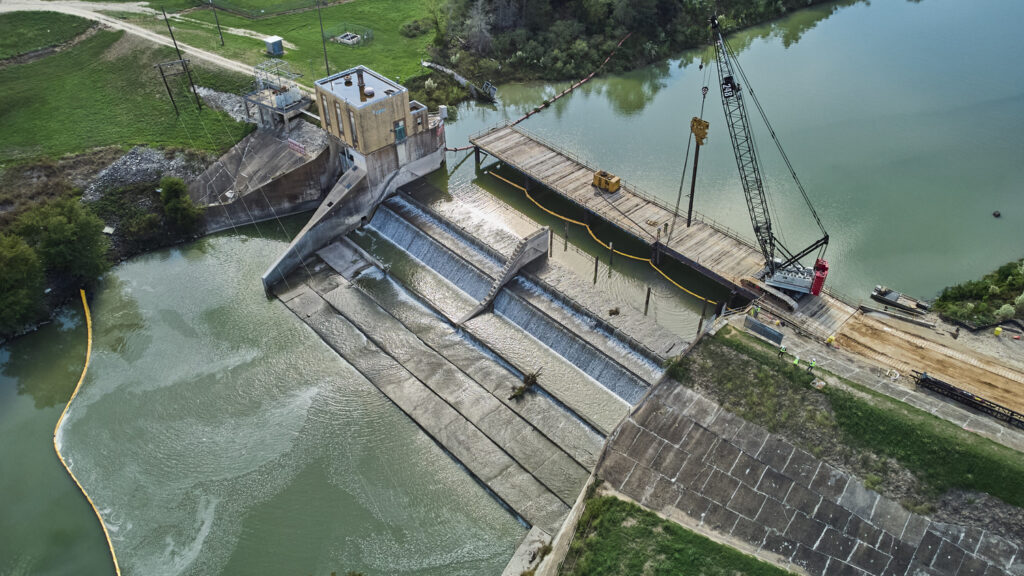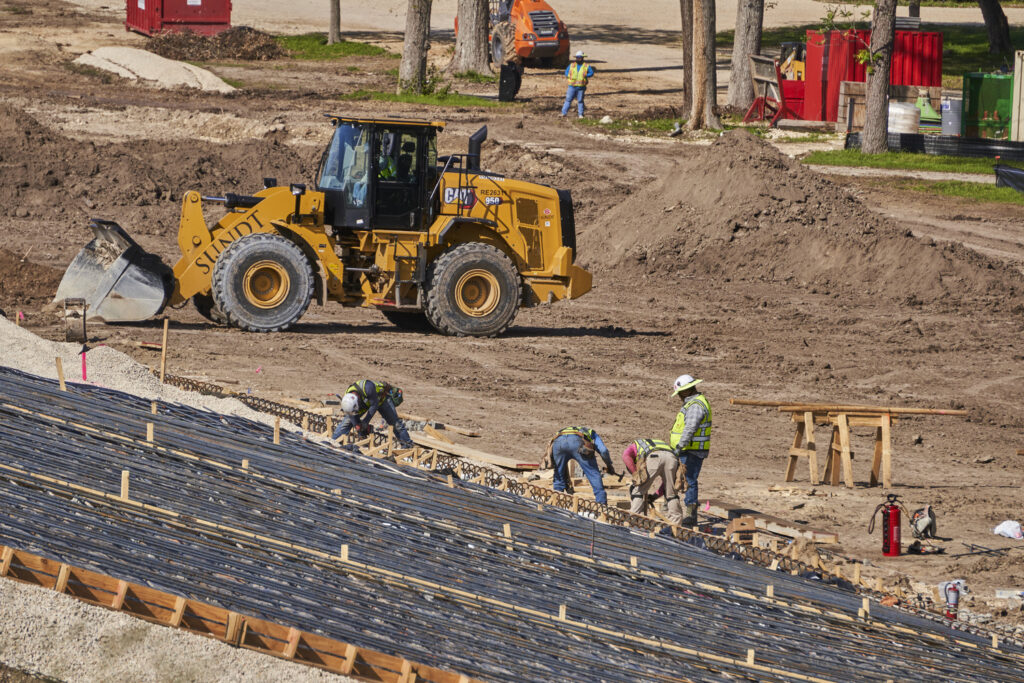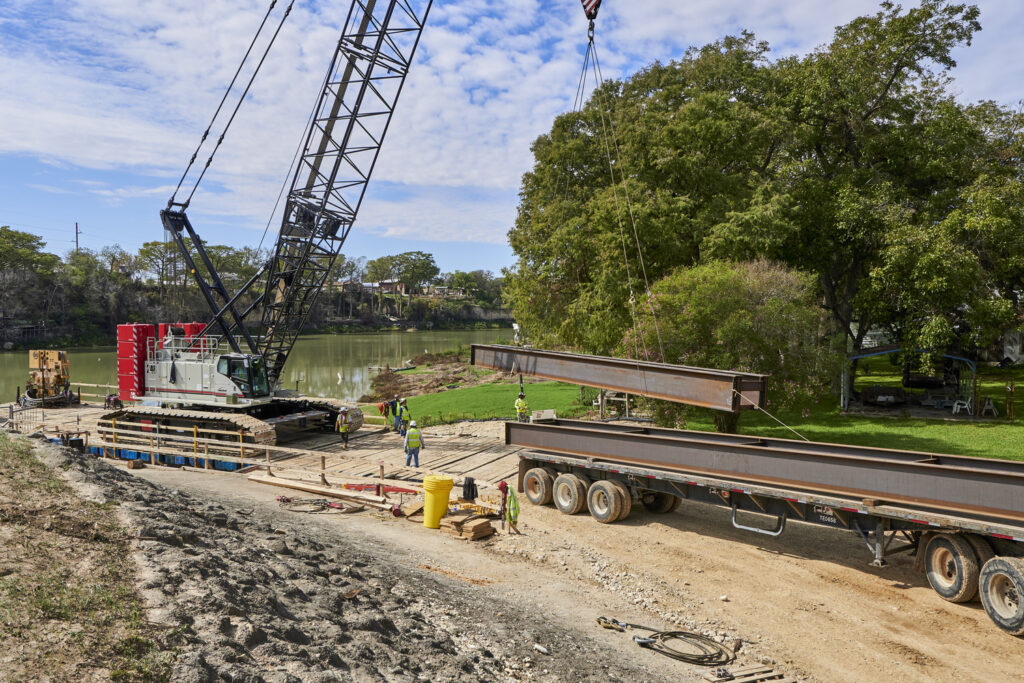
The Lake McQueeney and Lake Placid dams are among those along the Guadalupe River that are almost a century old. With catastrophic flood events becoming more common in Texas, the Guadalupe Blanco River Authority (GBRA) and passionate residents of the two lakes are taking action to revitalize two aging dams. They secured funding for renovations of the Lake McQueeney and Lake Placid dams through two water control improvement districts, Lake Placid Water Control and Improvement District and the Lake McQueeney Water Control and Improvement District. These funds will support the renovations of aging structures around the dam as well as replace the outdated gates with higher-end, modern gate technology. These upgrades will ensure that the lakes remain full for residents to enjoy and provide reliable safeguards against catastrophic flood events.
“The Lake McQueeney and Lake Placid residents are heavily involved and invested in the work Sundt is doing to revitalize their community lakes,” said Transportation Group Project Director Kevin Graf. “The project team meets with them and GBRA on a monthly basis to provide updates and maintain the positive relationship we have with the community. We’re excited to give the residents their lakes back.”
Modernizing the dams to secure the lakes’ future
The major scope of work entails replacing the outdated bear trap style gates with new hydraulically actuated steel crest gates, three at Lake McQueeney and two at Lake Placid. These are the same style gates that Sundt installed on the San Pedro Creek project in San Antonio, and our quality work and experience on that project helped us win this one. Additionally, much of the team from San Pedro Creek transferred to the GBRA dams projects following the completion of the major phases of the Creek, bringing their expertise with them.

Since the project is upgrading existing dams, special equipment and technology is used so that the team is able to work on the water. Before any major work could be done, each site had to have a temporary work bridge built where the team drove pipe pile to set steel beams and wood decking to support cranes out on the water. With these temporary work bridges in place, the team can then construct sheet pile cofferdams around the site that will dry everything up and keep the water at bay, allowing the team to dig into the real work. Once the water is gone, the project team can remove the old gates and add concrete to the foundation and piers to accommodate the new hydraulically actuated gates.
Off the water, Sundt is upgrading the dam embankment with armoring. The team will install a gravel drainage system on the existing embankments and then cover it with 8-inch concrete slope paving to provide stability.
Challenges over and underwater
Working on an active river is already a challenge, but the projects being in an active flood zone adds a major layer of complexity that the team had to meticulously plan around. In January, the river was hit by a flash flood upstream from the sites, causing water levels to rise. Thanks to the team’s excellent planning, the pre-existing work, such as the bridges and cofferdams, were built with proper elevation and durability to withstand water overflow.
“Our crew’s ability to learn fast and apply that knowledge to increase our efficiency has been amazing. Our first span on the bridge at Lake Placid took about two weeks to build, but by the time we were finishing the bridge at Placid we were finishing a span in only three days,” Graf said.
In addition to the work being done over water, there is also a lot of work going on underwater. Field Superintendent John Canales is an experienced piledriver heading up the delicate and challenging task of driving pile in the precise locations in the shale formations at the bottom of the lake. Sundt is also working with subcontractors with divers who perform specialty work like underwater jackhammering to break up the old concrete as well as cutting, torching, and welding to help seal up the sheetpile cofferdams.
“Working with limited visibility, not knowing what’s going on underwater has been a challenge for sure,” said Project Manager Clinton Witherell. “But through planning, adapting and reallocating resources, we haven’t let it impact our progress.”
SPARKs of creativity
The project team on site has been able to collaborate on a number of creative and innovative solutions with the guidance of the engineers and skilled craft.
The team was able to figure out how to drive pipe piles for the temporary work bridges by live shooting with the help of the survey crew and total station. Typically, driving these 30-inch piles would require the construction of a template for the pile driver to go between, which adds a significant amount of work, material and time. With the careful surveying and plotting of the survey team and total station, they were able to drive the pipe piles much more quickly but just as accurately. They’ve used Sundt’s SPARK Board as a resource for inspiration, as well as a place to share the solutions they’ve generated as a team.

“The Sundt SPARK Board has been an amazing resource to tap into all the construction innovations that employee-owners across the country have developed on their own projects,” said Project Engineer Halen Hartley. “We’ve been able to come up with some pretty good ideas like using the vibro hammer to break up the concrete and rigging pontoon boats to use in lieu of the much more expensive and difficult to procure pile driving barges. It’s been really cool and rewarding being able to work together with the rest of the team to come up with these creative solutions that save our team and the client time and money.”
What’s downstream
The current stage of the project involves demolishing the existing gates to make way for the upgraded ones and excavating between the existing dam foundation and the cofferdam. Then, concrete will be put in place for the foundation as well as structural abutment walls and center piers before installing the new hydraulically actuated, steel crest gates that will help to preserve the two lakes for decades to come. Residents in the surrounding area and along the lakes welcome Sundt’s presence, knowing that when complete, the renovations and upgrades to the outdated dam will keep their beloved lakes full and the environment thriving for decades to come. The GBRA Lake Placid and Lake McQueeney dams are expected to be completed by fall 2025.